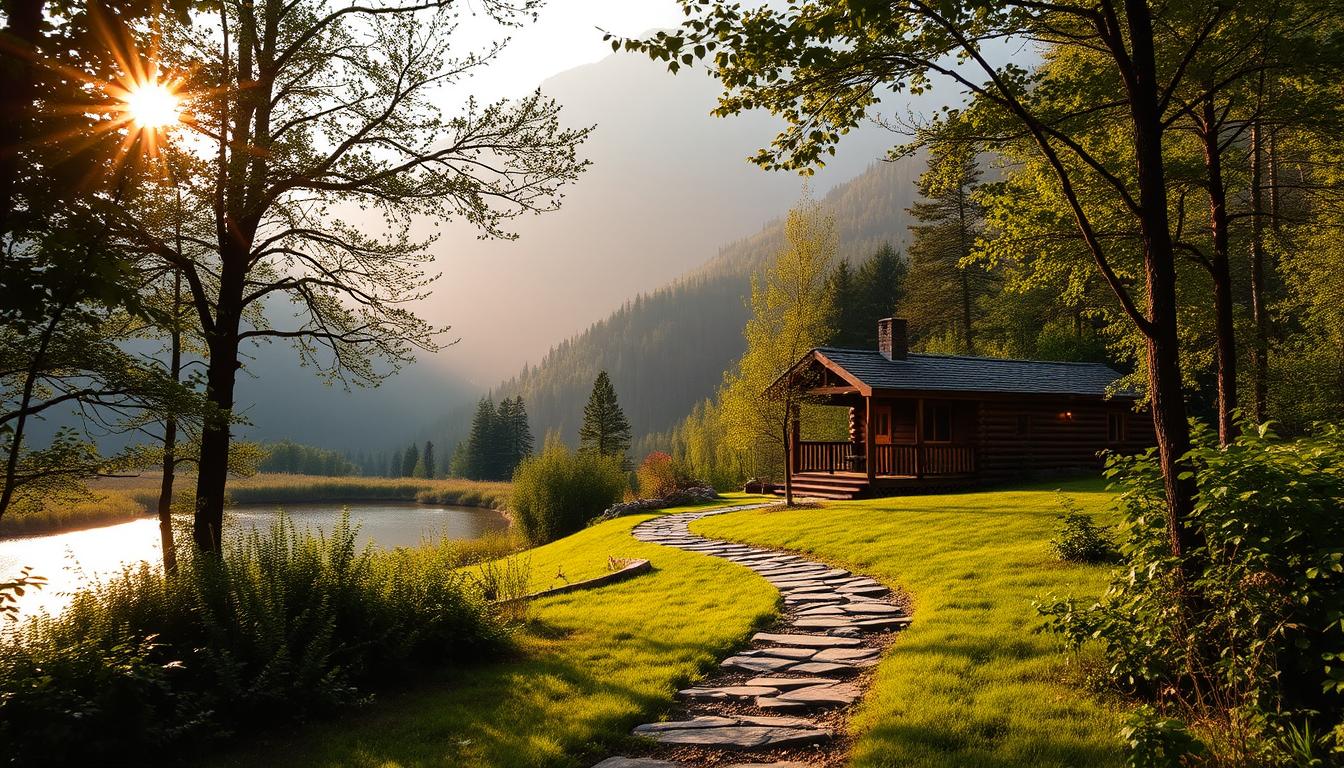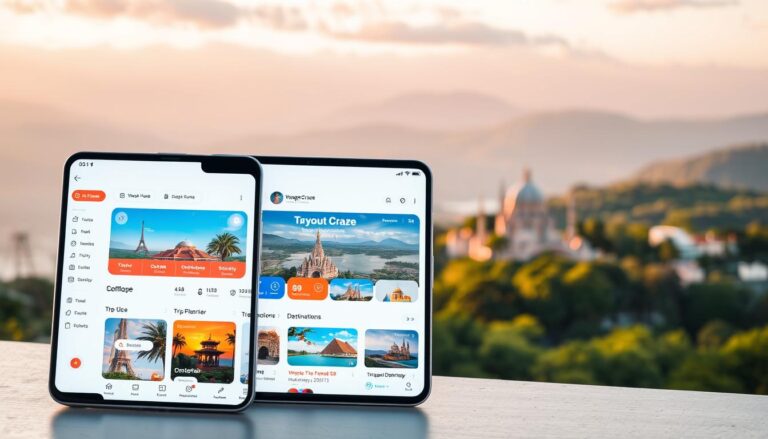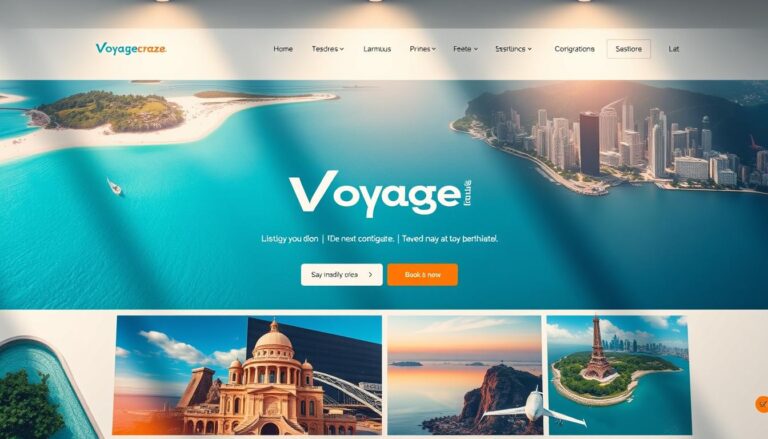Traveling is more than just visiting new places—it’s about creating meaningful experiences. The slow living philosophy encourages travelers to embrace a mindful approach, focusing on quality over quantity. This guide is designed to help you explore the world at the right pace, prioritizing what truly matters.
By aligning with this intentional lifestyle, you can curate journeys that are rich in culture and connection. This guide is rooted in facts and proven strategies, offering insights into history, sustainability, and mindful travel. It’s the best way to achieve fulfillment while exploring the globe.
Whether you’re seeking luxury or budget-friendly adventures, this guide provides expert advice and engaging storytelling. It’s tailored for global travelers who value authenticity and cultural immersion. Let’s embark on a journey that transforms the way you see the world.
Key Takeaways
- Slow living emphasizes quality experiences over quantity.
- Mindful travel focuses on cultural immersion and connection.
- This guide explores themes like sustainability and history.
- Expert advice and storytelling enhance your travel experience.
- Designed for travelers seeking authentic global adventures.
The History and Evolution of Slow Living
What began as a culinary protest in Italy grew into a global philosophy of mindful living. The slow food movement, launched in the 1980s, was a response to the rise of fast food and industrialized agriculture. It emphasized savoring meals, supporting local farmers, and preserving culinary traditions. This idea soon expanded beyond the kitchen, inspiring a broader cultural shift.
From Slow Food to a Global Movement
Influential voices like Carl Honoré and Brooke McAlary played pivotal roles in shaping the slow living movement. Honoré’s book, In Praise of Slowness, highlighted the need to decelerate in a fast-paced world. McAlary’s podcast, The Slow Home, offered practical tips for integrating this philosophy into daily routines. Their work resonated globally, encouraging people to rethink their approach to work, parenting, and leisure.
The movement’s evolution has touched various aspects of life, from travel to fashion. It’s not just about doing less—it’s about doing what truly matters. As Honoré once said,
“Slowing down is about doing everything as well as possible, instead of as fast as possible.”
Modern Trends and Cultural Shifts
The pandemic accelerated the adoption of slow living practices. With more time at home, people began to prioritize mindfulness and digital detoxes. This cultural shift emphasized the benefit of rest and self-care, helping many overcome the pressures of modern life.
Today, the movement continues to inspire new trends, including slow travel and slow fashion. It’s a reminder that quality always trumps quantity. By embracing this philosophy, individuals can create a more meaningful and balanced life.
Exploring the Slow Living Lifestyle
Intentionality is at the heart of the slow living movement, reshaping how we approach daily life. Unlike the conventional focus on busyness and productivity, this philosophy emphasizes quality over quantity. It’s about making deliberate choices that align with your values and priorities.
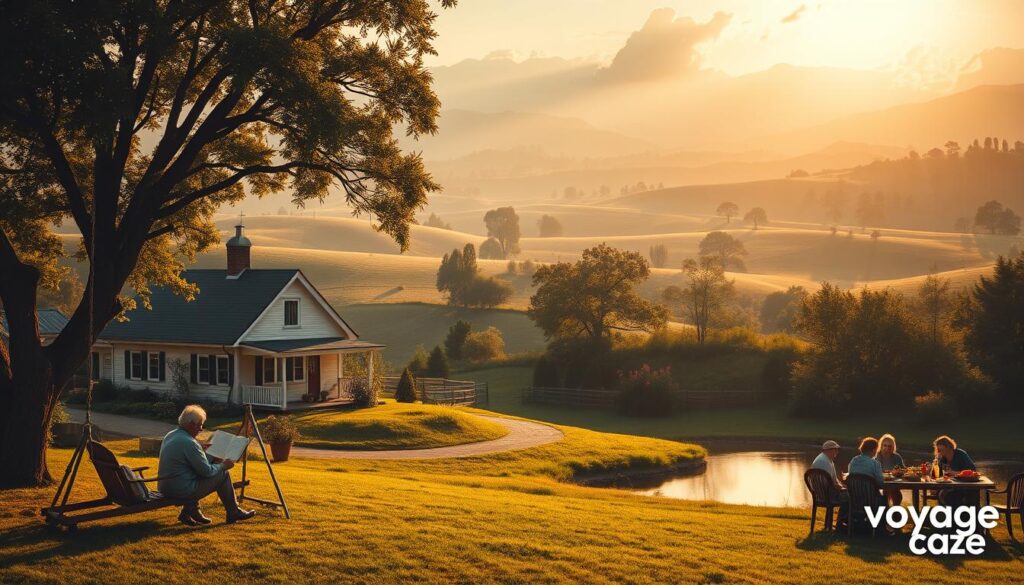
Defining the Mindset and Core Values
The slow living mindset encourages mindfulness and self-awareness. It’s not about doing less—it’s about doing what truly matters. Core values like quality time, balance, and authenticity take center stage. This approach fosters a deeper connection with yourself and the world around you.
For example, instead of rushing through meals, slow living advocates savoring each bite. This simple act can enhance both physical and mental wellbeing throughout the year. It’s a reminder to cherish the present moment.
Quality Over Quantity: A New Approach to Living
Slow living cherishes the body’s need for rest and recuperation. It encourages intentional activities that nourish both mind and body. Practices like meditation, journaling, or spending time in nature are key components of this lifestyle.
Every decision, from daily routines to travel planning, can be optimized for a richer experience. For instance, choosing to disconnect from digital devices allows for deeper connections with loved ones. This mindful approach fosters a sense of fulfillment and balance.
Adopting this lifestyle is a conscious, ongoing journey. It requires periodic adjustments to align with your evolving needs and priorities. By embracing slow living, you create a life that’s not just lived—but truly experienced.
Mindful Travel for a Purposeful Journey
Mindful travel invites you to explore the world with purpose and presence. It’s about creating journeys that prioritize quality over quantity, allowing you to connect deeply with destinations and cultures. By focusing on thoughtful planning, you can avoid the clutter of hectic schedules and embrace a more fulfilling travel experience.
Planning Slow Travel Itineraries
Creating a mindful travel itinerary requires allocating ample time to each destination. This approach minimizes stress and allows for unhurried exploration. Instead of rushing from one landmark to another, travelers can savor each moment and reflect on their experiences.
For example, spending a week in a single location fosters deeper connections with the local community. It also conserves energy, as you’re not constantly on the move. This method contrasts sharply with fast-paced travel jobs, which often prioritize quantity over quality.
Connecting Deeply with Local Cultures
Mindful travel emphasizes authentic cultural immersion. Engage with local traditions, cuisine, and history to create meaningful memories. Participating in community-driven activities, like cooking classes or artisan workshops, enriches your journey.
Another strategy is to support eco-friendly businesses and sustainable tourism initiatives. This not only benefits the environment but also fosters a deeper connection with the destination. By traveling with thought and intention, you leave a positive impact on the places you visit.
| Aspect | Fast-Paced Travel | Mindful Travel |
|---|---|---|
| Schedule | Packed and rushed | Flexible and unhurried |
| Energy | High consumption | Conserved and balanced |
| Cultural Connection | Superficial | Deep and meaningful |
| Stress Level | High | Low |
Adopting a mindful approach to travel transforms the way you experience the world. It’s not just about seeing new places—it’s about creating lasting connections and memories. Start planning your next journey with thought and intention, and discover the joy of purposeful travel.
Sustainable Living and Eco-Friendly Practices
Every choice we make leaves a lasting impact on the environment, shaping the world we live in. By adopting sustainable practices, we can reduce our ecological footprint and create a healthier planet for future generations. This approach not only benefits the earth but also enhances our own well-being.
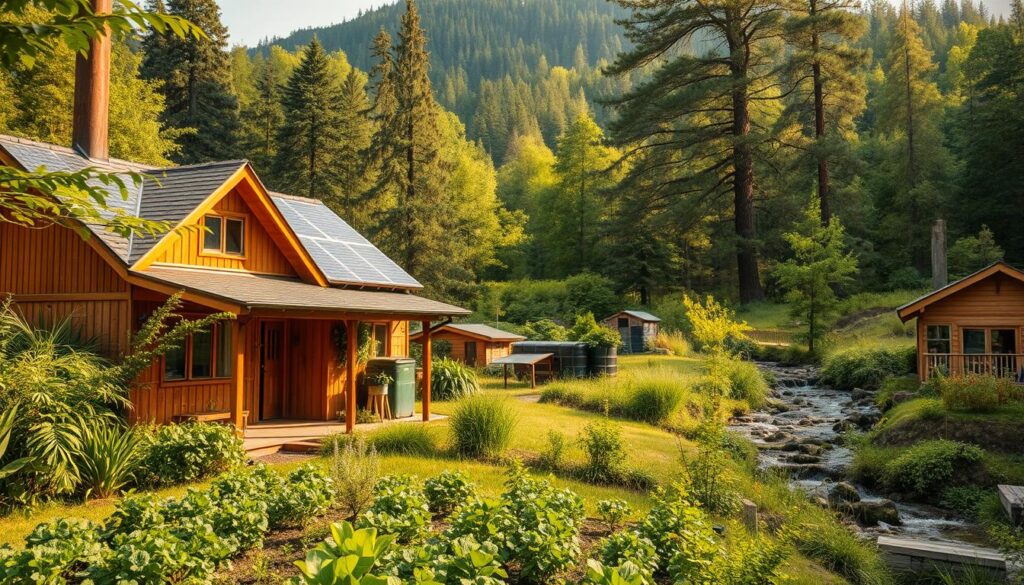
Reducing Your Environmental Impact
Minimizing stress on natural resources is key to sustainability. Simple changes, like using reusable items or supporting local producers, can make a significant difference. For example, studies show that mindful consumption can reduce waste by up to 30%.
One thing to consider is the ripple effect of your actions. Choosing eco-friendly products and conserving energy not only lowers your carbon footprint but also inspires others to follow suit. As Carl Honoré once said,
“Small changes can lead to big transformations.”
Seasonal Living and Natural Rhythms
Aligning daily routines with natural cycles fosters harmony and balance. Seasonal living encourages us to embrace the rhythms of nature, from eating locally sourced produce to adjusting our schedules with the changing seasons. This practice reduces stress and promotes a deeper connection with the environment.
A passionate commitment to sustainability transforms both personal and community life. By supporting local economies and reducing overconsumption, we create a more resilient and eco-conscious society. Start today—every choice matters.
How to Start Living Slower
Change begins when you align your actions with your deepest values. Embracing a more intentional pace requires clarity and purpose. It’s about making deliberate choices that enhance your well-being and bring meaning to your daily life.
Articulate Your Why and Set Clear Intentions
Understanding your core motivations is the first step. Ask yourself, “What do I want to prioritize in my life?” Whether it’s improving your health, spending more time in nature, or fostering deeper connections, your “why” will guide your journey.
Setting clear intentions helps you stay focused. Write down your goals and revisit them regularly. This practice keeps you aligned with your values and ensures your actions reflect your priorities.
Eliminate the Unnecessary from Your Life
Simplifying your life starts with removing distractions. Identify commitments that no longer serve you and let them go. This creates space for activities that truly matter, like reading a meaningful book or taking a peaceful walk.
Studies show that reducing clutter can lower stress levels and improve mental clarity. By focusing on what’s essential, you can create a more balanced and fulfilling life.
Establishing Slow Routines for Daily Peace
Building routines that promote balance is key. Start your day with mindfulness practices like meditation or journaling. These habits can improve your health and set a positive tone for the day.
Incorporate activities that reconnect you with nature, such as a daily walk or gardening. These simple acts can reduce stress and enhance your overall well-being.
Gradual change is more sustainable than drastic shifts. Start small and build on your successes over time. As Brooke McAlary once said,
“Small steps lead to big transformations.”
Consider reading influential books on intentional living to deepen your understanding. Titles like In Praise of Slowness by Carl Honoré offer valuable insights and inspiration.
Remember, this journey is about progress, not perfection. By taking intentional steps, you can create a life that’s rich in meaning and joy.
Reclaiming Time and Combating Burnout
Reclaiming time is the first step toward a healthier, more balanced life. In a world that often glorifies busyness, prioritizing rest and reflection can feel revolutionary. Yet, it’s essential for combating chronic burnout and restoring energy. By adopting a deliberate mindset, you can transform your pace of life and find deeper fulfillment.
Benefits of Rest and Reflection
Rest is not a luxury—it’s a necessity. Studies show that engaging in leisure activities can reduce stress levels by up to 30%. Taking time to reflect promotes mental clarity and helps you reconnect with your purpose. Simple practices like journaling or mindful walks can make a significant difference.
As Carl Honoré once said,
“Small changes can lead to big transformations.”
Incorporating moments of stillness into your day can improve focus and productivity by approximately 15%. It’s a powerfulwayto enhance both personal and professional life.
Overcoming the Hustle Culture
The hustle culture thrives on constant productivity, but it often leads to exhaustion. Breaking free requires a shift in mindset. Start by setting clear boundaries between work and personal time. This simple step can enhance well-being and reduce feelings of guilt associated with taking breaks.
Consider adopting practices like “niksen,” the Dutch concept of doing nothing intentionally. This approach encourages you to slow down and embrace the present moment. By prioritizing rest, you can create a more sustainable pace of life.
Here are some actionable steps to get started:
- Schedule regular breaks throughout your day.
- Engage in activities that bring joy and relaxation.
- Disconnect from digital devices during personal time.
Reclaiming time is not about doing less—it’s about doing what truly matters. By embracing this way of living, you can combat burnout and create a life filled with meaning and joy.
Balancing Work, Family, and Slow Living
Finding harmony between work, family, and personal well-being is a challenge many face in today’s fast-paced world. Juggling professional responsibilities while nurturing family connections can feel overwhelming. However, integrating intentional practices into your routine can create a sense of balance and fulfillment.
Strategies for Busy Lifestyles
Start by taking matters into your own hand. Prioritize tasks that align with your values and let go of non-essential commitments. For example, setting boundaries around work hours ensures you have dedicated time for family and self-care throughout the day.
Creating a calming home environment is another key step. Dedicate a space for relaxation, whether it’s a cozy reading nook or a quiet corner for meditation. This personal space can serve as a sanctuary amidst the chaos of daily life.
Small Habits, Big Impact
Incorporating small daily habits can make a significant difference. Begin your day with a mindful morning routine, such as journaling or stretching. These practices set a positive tone and help you stay grounded throughout the day.
Family dinners are another powerful habit. Research shows that shared meals strengthen bonds and reduce stress. By planning meals ahead of time, you can make this a consistent part of your routine.
Maintaining Productivity and Connection
Effective time management is essential. Use tools like calendars or apps to organize your day, ensuring you allocate time for both work and family. This approach minimizes stress and maximizes productivity.
Remember, balance is not about perfection. It’s about making intentional choices that enhance your well-being and strengthen your connections. As Brooke McAlary once said,
“Small steps lead to big transformations.”
| Strategy | Benefit |
|---|---|
| Setting Boundaries | Reduces stress and improves focus |
| Creating Personal Space | Enhances relaxation and mindfulness |
| Mindful Morning Routine | Sets a positive tone for the day |
| Family Dinners | Strengthens bonds and reduces stress |
By integrating these practices into your daily life, you can achieve a sense of balance without sacrificing professional or familial responsibilities. Start small, stay consistent, and watch how these changes transform your life.
Slow Living Inspirations: Books, Podcasts, and More
Exploring the world with intention can transform how you experience life. The right resources—books, podcasts, and thought leaders—can guide you toward a more meaningful and balanced existence. These tools act as essential steps to help you align your daily work with your deepest values.
Top Resources and Thought Leaders
Influential figures like Carl Honoré, Brooke McAlary, and Emma Gannon have shaped the intentional living movement. Honoré’s book, In Praise of Slowness, explores the benefits of decelerating in a fast-paced world. McAlary’s podcast, The Slow Home, offers practical tips for integrating mindfulness into daily routines. Gannon’s work emphasizes the importance of self-care and authenticity.
These thought leaders inspire millions to rethink their approach to work, relationships, and leisure. Their insights remind us that quality always trumps quantity.
Curated Lists for Continuous Motivation
Here’s a curated selection of resources to keep you inspired:
- Books: Slow: Simple Living for a Frantic World, Chasing Slow, and Make It Fast, Cook It Slow.
- Podcasts: The Slow Home Podcast, On Being, and The Minimalists Podcast.
- Digital Resources: TED Talks on mindfulness, Reddit communities like r/slowliving, and newsletters from thought leaders.
These resources provide both in-depth explorations and light, everyday inspirations. They’re designed to help you take the next step toward a purposeful life.
As Brooke McAlary once said,
“Small steps lead to big transformations.”
Success stories from these thought leaders demonstrate the tangible benefits of intentional living. For example, Stephanie O’Dea’s journey from fast-paced cooking to mindful living highlights the power of aligning work with personal values.
Join slow living communities and subscribe to newsletters for ongoing inspiration. These platforms foster connection and provide continuous motivation for your journey. Start today—every step matters.
Integrating Technology Mindfully
Technology, when used intentionally, can enhance rather than hinder our daily lives. The key lies in leveraging digital tools to support our goals while minimizing distractions. By adopting a mindful approach, we can create a healthier relationship with technology that adds value to our routines and relationships.
Using Tech Tools Without Distraction
Digital devices are powerful tools, but they can easily become sources of distraction. To use technology effectively, start by setting clear boundaries. For example, designate specific times for checking emails or social media. This simple idea helps maintain focus and reduces the urge to multitask.
Another strategy is to declutter your digital space. Unsubscribe from unnecessary notifications and delete apps that don’t serve a purpose. Research shows that 72% of users feel more productive after decluttering their devices. This practice fosters a sense of control and clarity.
Finding the Balance Between Digital and Real Life
Balancing screen time with real-world interactions is essential for well-being. Dedicate tech-free zones in your home, such as the dining area, to encourage meaningful family conversations. Studies reveal that shared meals strengthen bonds and reduce stress.
Periodically reassess your digital habits to ensure they align with your values. For instance, consider a weekly digital detox to recharge and reconnect with offline activities. As Carl Honoré once said,
“Small changes can lead to big transformations.”
By integrating these practices, you can create a harmonious balance between digital engagement and real-life experiences. This approach not only enhances productivity but also enriches your overall sense of fulfillment.
Conclusion
Embracing a deliberate pace can transform how we experience life’s moments. This guide has explored the evolution of intentional living, highlighting its benefits and offering practical strategies for a more fulfilling existence. From mindful travel to sustainable practices, each section emphasizes prioritizing what truly matters.
Review the curated list of resources and strategies provided throughout this article. These tools can help you navigate the contrast between a life dominated by hustle and one nurtured by heart-centered decisions. Remember, this journey is continuous and evolves over time.
Use this guide as a roadmap to reclaim your pace and create lasting change. Start today, and discover the joy of living with intention and purpose.
